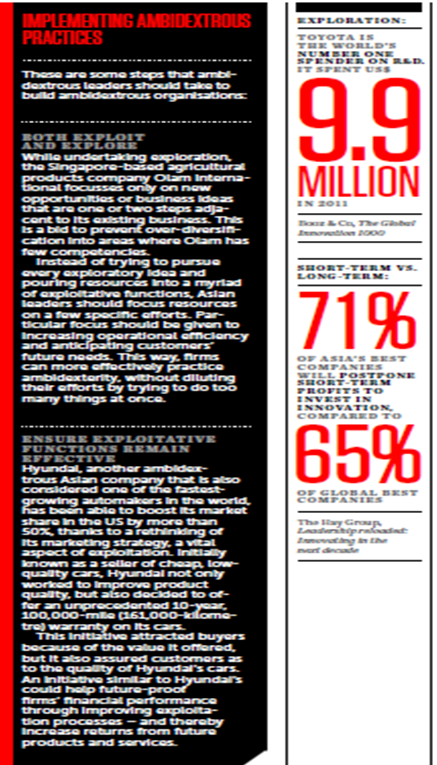Ambidexterity’ refers to the organisational capability to balance exploitation, the pursuit of short-term revenues, with exploration, which is investing in the long term. A 2013 study by Hay Group showed that most Asian firms surveyed prefer to pursue short-term gains, rather than investing in the future. Yet, having surveyed over 1,000 respondents from 100 companies across Asia, the research also reveals those same firms have weaker short-term financial performance.

Certain questions in the survey also indicated whether the organisation had a tendency towards ‘exploitation’ – whereby the firm provides incentives to encourage operational efficiency, or ‘exploration’ – whereby the firm recognises or rewards employees for new and different business ideas. Answers from the 100 Asian firms were aggregated, and the average scores derived were the firm’s exploitation and exploration scores. The exploration and exploitation scores of the 100 Asian firms were then matched against their EBITD (Earnings Before Interest, Taxes and Depreciation) margin, an indicator of the current operational profit-ability of a business. The results show that firms that best balanced exploitation and exploration have the highest EBITD margin, while organisations that gave little attention to exploration have the lowest figures.
In other words, there is a paradox in pursuing short-term financial performance. Focusing on the near future is counterproductive; if a business cares about its finances it needs to invest in long-term sustainability. Asian conglomerates Tata and Samsung are among the firms with the best exploration and exploitation scores in Hay Group’s study. They also have some of the highest EBITD margins, with an average figure of 26.5%.
These firms are better off in the long term as well. They have high long-term growth rates – both Samsung Electronics and Tata Motors enjoy five-year earnings-per-share growth rates of over 25%, according to data from Reuters – indicating investor confidence in their future performance. These numbers suggest that embracing ambidexterity is an effective way for Asian firms to future-proof, while posting strong short-term results.
Contrast the performance of Samsung and Tata with that of Asian firms who focus too much on either exploitation or exploration. For example, Chinese petrochemical giant, Sinopec’s exploitation score outweighs its exploration score, and – while it is the world’s fifth-largest company by revenue – Sinopec has an EBITD margin of only 6%.
In contrast, Indian wind power multinational Suzlon Energy has an exploration score that is higher than its exploitation score. A market leader, Suzlon Energy is committed to innovation in the emerging Asian clean energy market. It employs 500 workers in its R&D department and has developed a comprehensive portfolio of wind turbines. However, Suzlon Energy posted net losses in 2010 and 2011.
Neither exploration nor exploitation can take precedence. Organisations must find a balance.
Achieving Ambidexterity
Given the obvious importance of maintaining both short-term performance and long-term sustainability, how can Asian firms become more ambidextrous?
Ambidexterity must stem from leadership. Samsung and Tata are both family-controlled public companies. In their cases, the forward-thinking nature of family enterprises counterbalances the short-term profit-maximising orientation of public companies. Under such conditions, ambidextrous leadership can shine.
Business leaders are typically focussed on exploitation and short-term performance. However, Ratan Tata, in his former capacity as chairman of Tata Group, embarked on innovative exploration projects. For example, he famously decided to build a safe and affordable family car, creating the Tata Nano – the world’s cheapest car.
Tata took risks by initiating exploration in creating the Nano. While the car’s disappointing sales led to criticism that it had been a failure in the market, it was a pioneering foray into the novel concept of a micro car. Such willingness to engage in entrepreneurial risk-taking is a necessary characteristic of an ambidextrous leader.
How then does an organisation select such leaders? CEOs and company presidents are often under pressure to show their firms are doing well. Coupled with the likelihood of a CEO having a traditional finance or sales background, this tends to result in a focus on short-term financial performance. It may take a leader with an exploration-heavy background to bring some balance to the usual preference for exploitation.
At Samsung, for example, the company’s CEO and Vice-Chairman of Samsung Electronics, Dr Oh-Hyun Kwon, has a background in R&D, with extensive experience leading the company’s development of memory device technology. Such leaders are often better equipped to bring an exploratory dimension to an otherwise exploitation-oriented leadership role.
In order to cultivate ambidexterity, firms could also emulate family-controlled businesses by making decisions regarding exploitation and exploration at the highest level. In his article The Ambidextrous CEO, Michael Tushman states that decisions to fund exploratory efforts should not be left to middle managers, who tend to favour the old established ways to ensure good performance from their respective units.
Unfortunately, in Asian firms, though such decisions are typically made at a high level – they are not made at C-level. To balance exploitation with exploration, business leaders should put the decision-making process firmly at the C-level and give exploratory departments representation and equal voice at the top of the corporate ladder.
Samsung’s Chairman Lee Kun-Hee personally leads the Samsung Advanced Institute of Technology (SAIT). Having top leadership involved in planning R&D is a good way to put exploration on par with exploitation in C-level decision-making, and in Samsung the results speak for themselves. Under Lee’s leadership, SAIT’s efforts have translated into strong and tangible business results, such as Samsung’s market leadership in the mobile phone market.
A New Wisdom
Ambidexterity is important to a firm’s financial performance. The journey of a thousand miles does begin beneath one’s feet, as Lao Tzu once said, but Asia’s business leaders must also realise that one takes longer strides when one’s aim is to walk such a long way. Keeping an eye on the future will make a crucial difference to firms’ present efforts.


